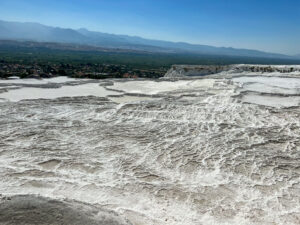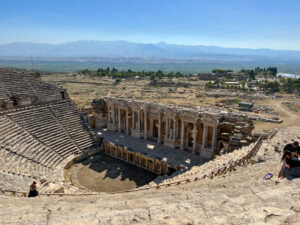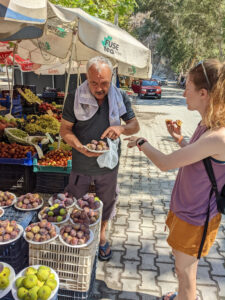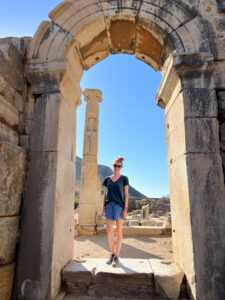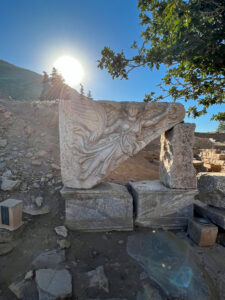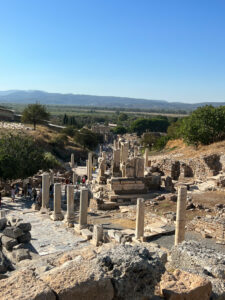
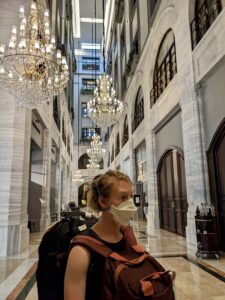
There were several reasons that I chose to explore Turkey on a group tour instead of just with Michael. First, I had toured Morocco on a group tour before, so I knew from experience that we would learn so much more about culture and history with a local guide than we would on our own, especially since we had limited time. (We were there for 16 days, which doesn’t sound like a short time, but it’s no time at all when you consider how huge and rich with history Turkey is.) I also thought Michael would like the social aspect of a tour. I am the type of introvert who’s content wandering totally alone for weeks at a time, but for Michael, everything he finds joy in involves other people. A tour would be a chance for us to both meet new friends. The price was another reason. I paid a little under $800 for the 11 night/12 day tour, and that included all hotel rooms (some of the nicest 4 and 5 star hotels I’ve ever stayed in), 11 breakfasts and 8 dinners, several sites we visited, plus all transportation. Could we have spent the same amount of time in Turkey on our own for less money? Yes, absolutely, BUT we definitely couldn’t have done it for less and stayed in accommodations nearly this nice and done all of the activities we got to do since some of the activities would have been very difficult (or impossible) to reach by public transportation. There were some activities that we wouldn’t have even known about on our own, no matter how long I spent researching.
And perhaps the biggest reason I chose this country for our group tour was because I knew it would feel like a luxurious break. I’d been traveling for 2 months at that point, mostly navigating public transportation, currencies, and unfamiliar languages alone. Michael had joined me two weeks before, but those two weeks were some of the most logistically challenging of the trip as far as transportation. I knew that we would welcome the luxury of having a reliable and air-conditioned bus waiting right outside our fancy hotel every morning for us. It’s not the way I’d choose to travel most of the time, but it’s definitely something I recommend everyone try once for the convenience, value, and fun of it.
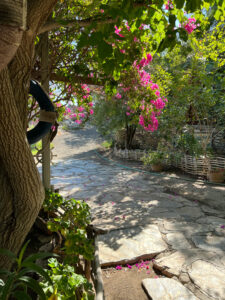
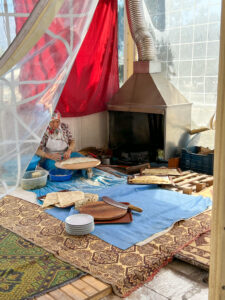
After leaving Istanbul, we headed down the coast to Gallipoli and ANZAC Cove. It was interesting to see because this is history I’m not very familiar with. ANZAC stands for Australian and New Zealand Army Corps, and the site is where a significant World War I campaign took place. I didn’t feel the emotional impact of it the way that those on the tour from Australia and New Zealand did, but it was interesting to think about how this is a place for them that might feel like visiting Normandy or Pearl Harbor would to me. I hadn’t given much thought before to how many places around the world hold this kind of significance for certain nations without even being on the radar of others.
We officially crossed into Asia that day—my 4th continent. The actual border is contested and holds no literal significance to anyone, but I was still delighted. We headed down the coast to Troy the next day. During the summer before my senior year in high school, I took a history class at Ole Miss, and I vividly remember reading the Iliad for the class like it was the most riveting thing I’d ever touched. I knew all about Troy and its history, but somehow I hadn’t realized until recently that Troy is still a place one can visit. In a place like this, it’s hard to contextualize the history you’ve read about with the physical place where you’re standing. Nothing about it seems real. The landscape has changed so much since the time of Homer, and what was once covered by water is now a vast plain. Centuries of earthquakes in the region have destroyed much of what’s left. And since the site was discovered relatively recently, not much of it has been excavated. There’s about 4,000 years of history here, and you can walk through the excavation sites where archaeologists are slowly uncovering 9 different layers of the 9 different eras of the city. And if you need some extra help imagining it as the Troy from the myth, they’ve supplied a lovely Trojan horse for tourists to take photos with.




Six hours to the south, we visited the ancient city of Ephesus. Unlike with Troy, it wasn’t hard to visualize what Ephesus used to be at all. As a person who almost pursued a graduate degree in early Christian history, I need you to know that I got a bit teary at the sight of it. Paul wrote here, and Herodotus. Mary and John were here (some claim Mary is buried nearby), and Marc Antony and Cleopatra. Only about 20% of Ephesus has been excavated, but it’s remarkably well-preserved and what isn’t entirely original has been seamlessly reconstructed. What’s left of the Temple of Artemis is here—one of the 7 Wonders of the World. The reconstructed Library of Celcus here was the third largest library in the world at the time, and it’s one of the most incredible ancient monuments I’ve ever seen.
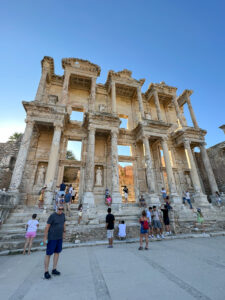

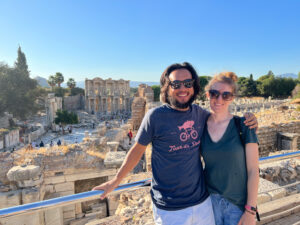

And then we headed even farther south to the beach destination of Fethiye, one of my favorite parts of Turkey. We took a mud bath and then rode a boat through winding marsh paths past the over-2,000 year-old Lycian rock tombs in Daylan. They were built into the side of mountains so the angels could reach them. We saw sea turtles and ate fresh crab that a man delivered to us in a boat, and we spent half a day on a beach that you can only access by water and where baby sea turtles hatch each year. The water felt as warm as a bath, and it was so shallow that I swam out farther into the Aegean than I’ve ever been in a sea. We visited the Saklikent Gorge and walked through the actual coldest water I’ve ever stood in in my life to reach the canyon on the other side. At first it felt like a terrible burn, and then it felt like your legs turned into numb weights. Shepherds herded their goats alongside the gorge, and I bought fresh figs from a man along the roadside. We visited Oludeniz Beach and the Blue Lagoon where the wealthy Europeans come on vacation.
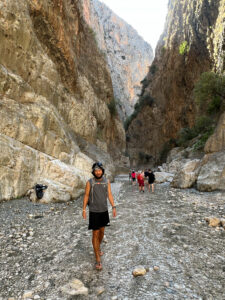
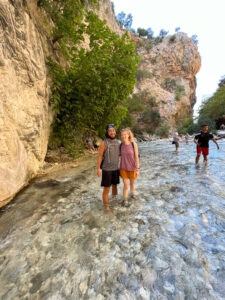
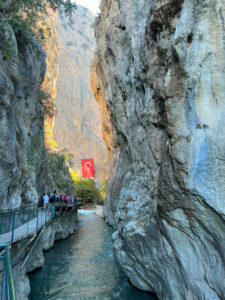
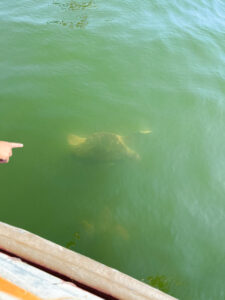


We were in our hotel in Fethiye when the Queen died. The hotel held a moment of silence, and it felt unifying and beautiful to see people from around the world, most of whom had probably never visited the UK, sharing this moment of reverence and respect.
It was another long drive to Pamukkale. It was almost 100 degrees there, and there was hardly any shade. A lot of the thermal springs that it’s famous for were dry. But the ruins of Hierapolis were stunning, especially the giant amphitheater. At the hostel spa, a bunch of us had a Turkish bath and massage. I didn’t know what to expect, but basically it was a massage first and then for the bath, you had to lay on a concrete slab while the masseuse scrubbed your body like she was trying to rub the skin off. I wanted to tell the lady during the bath, “Could you please not scrub my head quite so vigorously, and also I’m afraid you’re giving me third degree burns with that water you’re tossing on me,” but it was memorable and I’m glad I did it.

